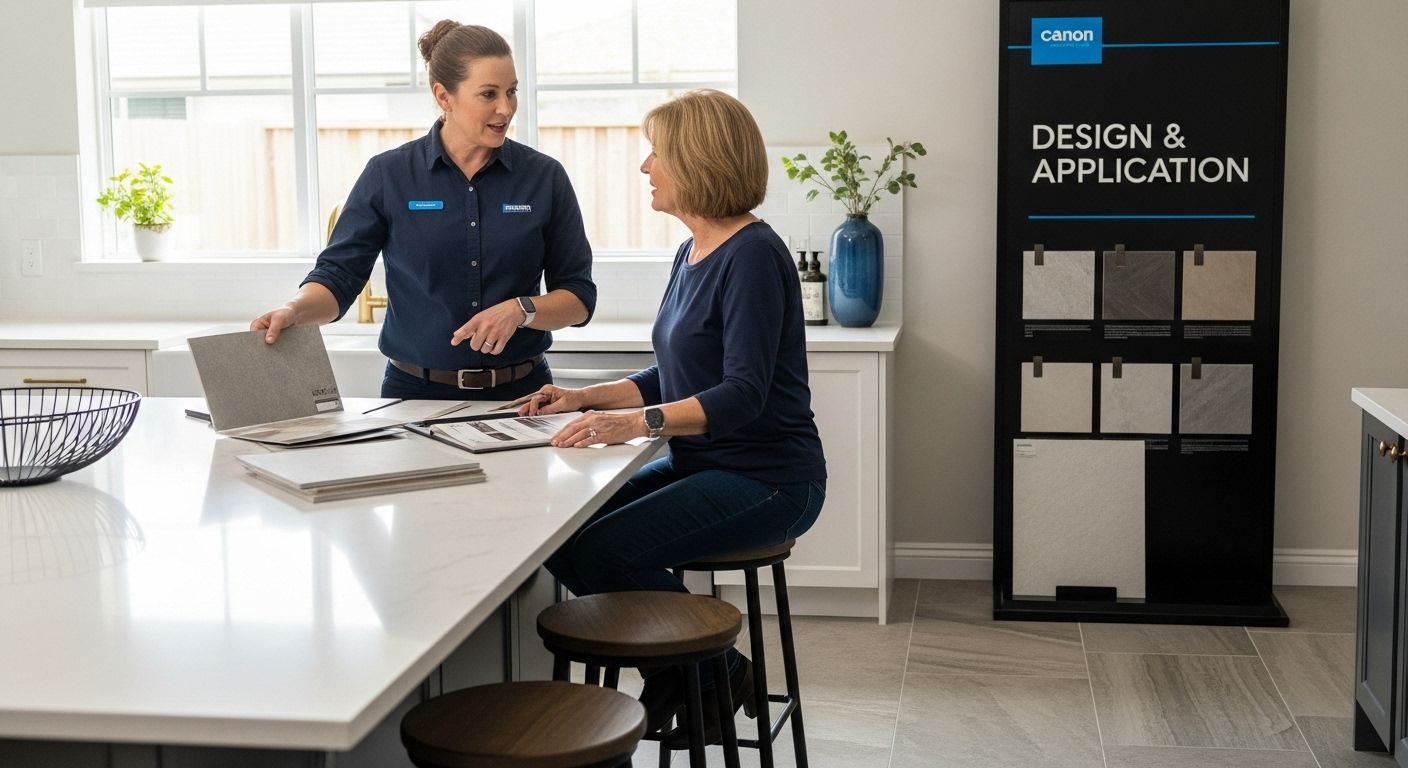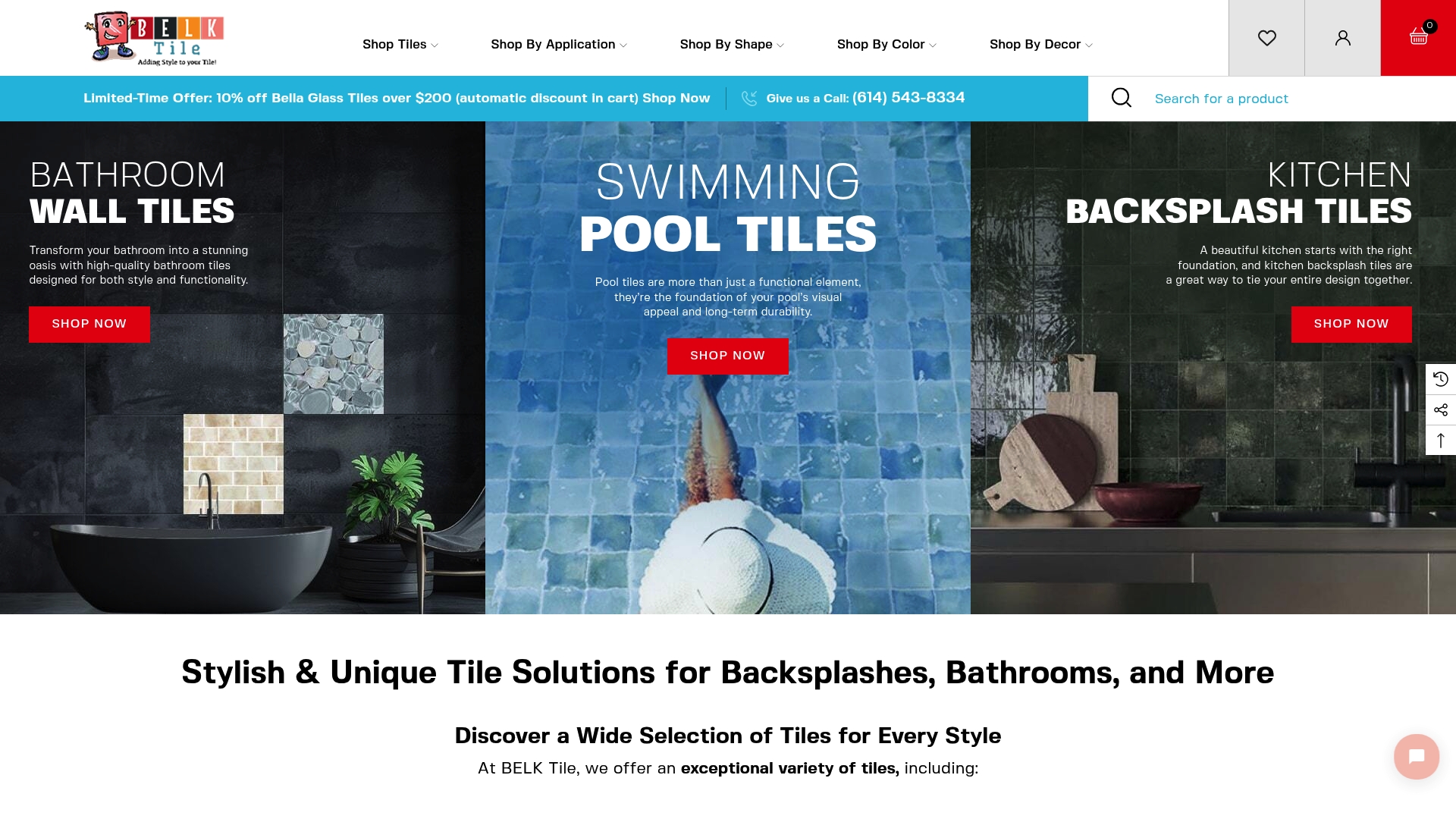What is Porcelain Tile? Understanding Its Unique Qualities
Posted by Mike Belk on Aug 19, 2025

Porcelain tile has changed the way we think about floors and walls. Most people know it looks great and stands up to everyday wear, but what really sets porcelain apart is how it is made.
Some porcelain tiles have a water absorption rate of less than 0.5 percent, making them almost completely waterproof compared to ordinary ceramic. That tight seal comes from a blend of special clays and firing temperatures hotter than lava, turning raw powder into a surface that outperforms expectations in almost any space.
Table of Contents
- Defining Porcelain Tile: Material And Composition
- The Importance Of Porcelain Tile: Benefits And Features
- How Porcelain Tile Is Made: The Manufacturing Process
- Applications Of Porcelain Tile: Where And Why It’s Used
- Understanding Porcelain Tile Varieties: Types And Styles
Quick Summary
| Takeaway | Explanation |
|---|---|
| Porcelain tile offers exceptional durability. | It withstands wear, moisture, and chemical exposures, making it ideal for high-traffic and demanding environments. |
| Low water absorption is a key feature. | With less than 0.5% water absorption, porcelain tile is especially suited for moist areas like kitchens and bathrooms. |
| Versatile design options replicate natural materials. | Porcelain tiles can imitate wood, stone, or concrete, providing aesthetic flexibility without sacrificing durability. |
| Manufacturing involves high-temperature firing. | This process vitrifies the tile, leading to a dense, impermeable surface that enhances strength and performance. |
| Various categories exist for tailored applications. | Tiles are classified by performance, design, and manufacturing techniques, helping users select suitable options for their needs. |
Defining Porcelain Tile: Material and Composition
Porcelain tile represents a sophisticated and engineered flooring material that goes far beyond basic ceramic construction. Unlike standard ceramic tiles, porcelain tiles are crafted through a precise manufacturing process involving specialized clay compositions and extreme firing temperatures, resulting in an exceptionally dense and durable product.
Below is a table comparing porcelain tile with standard ceramic tile based on key features and performance. This helps highlight what sets porcelain apart and guides readers in material selection.
| Feature/Characteristic | Porcelain Tile | Standard Ceramic Tile |
|---|---|---|
| Water Absorption Rate | Less than 0.5% | Greater than 0.5% |
| Main Ingredients | Kaolin clay, feldspar, quartz | Mixed clays, less refined |
| Firing Temperature | 2,200 - 2,500°F | Lower than 2,200°F |
| Density | High | Moderate |
| Durability | Exceptional | Good |
| Stain & Moisture Resistance | Excellent | Good to moderate |
Clay and Raw Material Composition
At its core, porcelain tile begins with a meticulous blend of refined materials. The primary ingredients include kaolin clay, feldspar, and silica quartz, each playing a critical role in creating the tile’s fundamental characteristics. According to ANSI Standards, these materials are carefully proportioned and processed to achieve a water absorption rate of less than 0.5%, which distinguishes porcelain from standard ceramic tiles.
The raw material composition typically involves:
- Kaolin clay, providing structural integrity
- Feldspar, acting as a natural flux and lowering the melting point
- Quartz, contributing to hardness and durability
Manufacturing Process and Transformation
The transformation of raw materials into porcelain tile occurs through an intricate process of pressing and firing at extremely high temperatures, typically between 2,200 to 2,500 degrees Fahrenheit. This intense heat causes the ingredients to vitrify, creating a nearly impenetrable surface that is remarkably resistant to moisture, stains, and wear.
The high-temperature firing not only densifies the tile but also enables manufacturers to produce tiles with incredibly consistent coloration and minimal variation. This process allows for both through-body coloration, where the color runs consistently through the entire tile, and surface-glazed options that provide additional decorative possibilities.
Learn more about tile selection for your home renovation.
The Importance of Porcelain Tile: Benefits and Features
Porcelain tile has emerged as a premier flooring solution, offering unparalleled performance and aesthetic versatility across residential and commercial spaces. Its exceptional characteristics make it far more than just a surface covering, transforming into a strategic design and functional element for modern environments.
Durability and Long-Term Performance
The extraordinary durability of porcelain tile sets it apart from other flooring materials. Research from the CDC highlights its remarkable resistance to wear, moisture, and chemical exposure, making it an ideal choice for high-traffic areas. Porcelain tiles can withstand extreme conditions without compromising their structural integrity or visual appeal.
Key performance characteristics include:
- Exceptional scratch and impact resistance
- Minimal moisture absorption
- Resistance to temperature fluctuations
- Minimal color fading over time
Versatility in Design and Application
Beyond its technical superiority, porcelain tile offers unprecedented design flexibility. Modern manufacturing techniques allow for an incredible range of visual effects, mimicking natural materials like wood, stone, and marble with remarkable precision. This versatility enables designers and homeowners to achieve sophisticated aesthetics without sacrificing performance.

Porcelain tiles can be used in diverse settings including:
- Indoor flooring across residential and commercial spaces
- Exterior patio and walkway installations
- Kitchen and bathroom wall coverings
- Commercial and industrial environments
Discover more about porcelain tile benefits for your specific design needs and requirements.
How Porcelain Tile is Made: The Manufacturing Process
Porcelain tile production represents a sophisticated blend of scientific precision and advanced manufacturing techniques, transforming raw materials into a resilient and aesthetically versatile product through a meticulously controlled process. The journey from raw ingredients to finished tile involves multiple complex stages that ensure exceptional quality and performance.
The following table outlines the step-by-step stages in the porcelain tile manufacturing process, summarizing the key activities and objectives of each stage for reader clarity.
| Stage | Main Activities | Purpose/Outcome |
|---|---|---|
| Raw Material Preparation & Mixing | Selecting, proportioning, mixing clays (kaolin, feldspar, silica); removing impurities | Achieve ideal blend and consistency |
| Forming & Pressing | Dry pressing or extruding; applying high pressure | Shape tile bodies; ensure uniform thickness |
| Firing & Final Processing | Heating tiles to 2,200-2,500°F; vitrification | Create dense, waterproof, durable tile surfaces |
![]()
Raw Material Preparation and Mixing
The initial stage of porcelain tile manufacturing focuses on carefully selecting and proportioning raw materials. Specialized clay mixtures, including kaolin, feldspar, and silica, are precisely measured and combined to create a foundational blend. According to The American Ceramic Society, this preparation is critical in determining the tile’s ultimate characteristics.
Key considerations during raw material preparation include:
- Maintaining consistent material ratios
- Ensuring uniform particle size and distribution
- Removing potential impurities
- Achieving optimal chemical composition
Forming and Pressing Techniques
Once the raw material mixture is prepared, manufacturers employ advanced forming techniques to shape the tile. The most common methods include dry pressing and extruding, which transform the powdered material into dense, uniform tile bodies. Hydraulic presses apply immense pressure, typically ranging from 400 to 1,000 kilograms per square centimeter, compacting the material into precise shapes and dimensions.
The pressing process involves:
- Applying controlled pressure to eliminate air pockets
- Creating uniform tile thickness
- Establishing the tile’s initial structural integrity
- Preparing the surface for subsequent glazing or finishing
Firing and Final Processing
The final and most critical stage involves firing the pressed tiles at extremely high temperatures, typically between 2,200 and 2,500 degrees Fahrenheit. This intense heat triggers vitrification, a process where the materials partially melt and fuse, creating an incredibly dense and impermeable tile surface. Precise temperature control determines the tile’s ultimate strength, water resistance, and visual characteristics.
Explore our comprehensive tile manufacturing insights to understand the intricate process behind these remarkable materials.
Applications of Porcelain Tile: Where and Why It’s Used
Porcelain tile has transcended its traditional role as a mere flooring material, emerging as a versatile solution for diverse architectural and design environments. Its exceptional performance characteristics make it an ideal choice for residential, commercial, and industrial applications, offering unparalleled durability and aesthetic flexibility.
Residential Space Applications
In residential settings, porcelain tile provides homeowners with a resilient and visually stunning surface solution. Kitchens, bathrooms, and living areas benefit from its remarkable properties, offering resistance to moisture, stains, and daily wear. According to the U.S. National Park Service, porcelain tile’s low water absorption rate makes it particularly suitable for high-moisture environments.
Typical residential applications include:
- Kitchen countertops and backsplashes
- Bathroom floor and wall coverings
- Fireplace surrounds
- Outdoor patio and deck areas
Commercial and Public Space Implementations
Commercial environments demand flooring solutions that can withstand intense traffic and maintain aesthetic appeal. Porcelain tile meets these rigorous requirements, making it a preferred choice for hospitals, airports, shopping centers, and educational institutions. Its ability to mimic natural materials like wood, stone, and marble allows designers to create sophisticated spaces without compromising on performance.
Key commercial application areas encompass:
- Retail store flooring
- Hospital and healthcare facility surfaces
- Educational institution corridors and common areas
- Restaurant and hospitality space design
Specialized and Industrial Applications
Beyond traditional spaces, porcelain tile finds innovative applications in specialized environments. Its chemical resistance, thermal stability, and robust structural integrity make it valuable in settings requiring exceptional material performance. From industrial laboratories to architectural facades, porcelain tile continues to expand its functional boundaries.
Unique application domains include:
- Laboratory and cleanroom flooring
- Architectural exterior cladding
- Industrial workspace surfaces
- High-temperature environment installations
Explore design possibilities for your specific space and discover how porcelain tile can transform your environment.
Understanding Porcelain Tile Varieties: Types and Styles
Porcelain tile represents a sophisticated category of ceramic materials with remarkable diversity, offering designers and homeowners an extensive range of aesthetic and functional options. The intricate manufacturing processes and advanced technologies enable porcelain tiles to transcend traditional design limitations, providing solutions that can adapt to virtually any architectural vision.
This table presents the main types of porcelain tiles based on manufacturing and design, along with their distinguishing features. It can help readers quickly grasp style and performance options.
| Type of Porcelain Tile | Description/Feature |
|---|---|
| Through-body | Color and composition consistent throughout tile |
| Glazed | Decorative surface glaze for variety of designs |
| Full-body | Uniform coloration and material throughout |
| Rectified | Precisely machine-cut edges for exact sizing |
| Wood-look | Mimics grain patterns of natural wood |
| Stone-look | Imitates marble, granite, or other natural stones |
| Concrete-inspired | Offers urban, contemporary appearances |
Categorization by Manufacturing Technique
According to ANSI Standards, porcelain tiles are classified based on their unique manufacturing techniques, which fundamentally influence their performance characteristics. The primary manufacturing methods determine the tile’s structural integrity, water resistance, and visual appearance.
Key manufacturing categories include:
- Through-body porcelain tiles with consistent color and composition
- Glazed porcelain tiles with decorative surface treatments
- Full-body porcelain tiles featuring uniform coloration throughout
- Rectified porcelain tiles with precise machine-cut edges
Design and Visual Style Variations
Modern porcelain tile technology allows for unprecedented design flexibility, enabling manufacturers to replicate natural materials with extraordinary precision. Cutting-edge printing and texturing techniques create tiles that closely mimic the appearance of wood, stone, marble, and even intricate textile patterns, providing aesthetic versatility without compromising performance.
Design style varieties encompass:
- Wood-look porcelain tiles with realistic grain patterns
- Stone-look tiles mimicking natural marble and granite
- Concrete-inspired urban contemporary designs
- Geometric and abstract pattern collections
Technical Performance Categories
Beyond aesthetic considerations, porcelain tiles are scientifically classified according to their technical performance metrics. These classifications help professionals and homeowners select the most appropriate tile for specific environmental conditions and usage requirements.
Performance categories include:
- Commercial-grade tiles for high-traffic environments
- Residential-grade tiles for standard home applications
- Exterior-rated tiles for outdoor and extreme weather conditions
- Specialized tiles for wet areas and moisture-prone spaces
Explore comprehensive tile selection strategies to find your perfect design solution.
Elevate Your Space with Porcelain Tile – Discover Lasting Quality and Beautiful Design
Are you looking for a flooring option that protects your investment while enhancing the style of your home or business? The article highlighted the pain of finding a material that not only lasts but also resists water, stains, and heavy traffic. Porcelain tile, created with advanced techniques and high-grade clays, solves this challenge by delivering exceptional durability and design versatility. If you want a surface that stands up to daily life while looking stunning, it’s time to explore your options.

Experience how easy it can be to shop for high-quality porcelain tile with BELK Tile. Our ecommerce platform brings you a curated range of porcelain choices, each with detailed product listings and style inspiration. Browse expert porcelain tile advice or see how our solutions compare in real projects through our tile selection guide. Now is the best time to find the perfect surface for your next project. Visit BELK Tile and transform your vision into reality today.
Frequently Asked Questions
What is porcelain tile made of?
Porcelain tile is primarily made from a blend of kaolin clay, feldspar, and silica quartz. This composition gives it exceptional density and durability, distinguishing it from standard ceramic tiles.
How does porcelain tile differ from ceramic tile?
Porcelain tile has a lower water absorption rate of less than 0.5%, making it more resistant to moisture and stains compared to ceramic tile. Additionally, it is fired at higher temperatures, resulting in greater density and durability.
What are the benefits of using porcelain tile in homes?
Porcelain tile offers numerous benefits including exceptional durability, resistance to scratches and stains, versatility in design, and suitability for both indoor and outdoor applications, making it ideal for various home environments.
Can porcelain tile be used outdoors?
Yes, porcelain tile is well-suited for outdoor use due to its durability and low water absorption rate, which helps prevent damage from moisture and temperature fluctuations.



